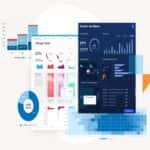Summary: Power BI is a leading data analytics platform offering advanced features like real-time analytics and collaborative capabilities. Understanding its significance is vital for aspiring Power BI developers. With its intuitive interface, Power BI empowers users to connect to various data sources, create interactive reports, and share insights effortlessly. Mastering Power BI can significantly enhance career prospects, given its prevalence in the industry. Optimising Power BI reports for performance ensures efficient data analysis. Power BI proficiency opens doors to lucrative data analytics and business intelligence opportunities, driving organisational success in today’s data-driven landscape.
2024’s top Power BI interview questions simplified
With a 36% market share, Power BI is the most popular data analytics platform among businesses. Understanding its significance is crucial, especially for aspiring Power BI developers. Preparing for Power BI interviews is paramount, given the competitive landscape.
In earlier articles, you read about creating a heatmap in Power BI and a complete PowerBI tutorial. This article aims to unravel the mysteries surrounding common, complex, and highly challenging Power BI interview questions.
Additionally, it’s noteworthy that Power BI Developer salaries in India typically range between ₹3.6 Lakhs to ₹9.0 Lakhs, with an average annual wage of ₹6.0 Lakhs. Understanding the depth of Power BI can significantly enhance career prospects.
Key takeaways
- Power BI is vital for businesses, with a 36% market share.
- Understanding fundamental concepts like data loading and visualisation is crucial.
- Advanced topics like DAX, row-level security, and performance optimisation are essential for complex analysis.
- Power BI integrates with other Microsoft services for seamless collaboration.
- Real-world applications include sales analysis for optimising strategies and increasing revenue.
Basic Power BI interview questions and answers
As we delve into the realm of Basic Power BI interview questions, it’s crucial to grasp the fundamental concepts that lay the groundwork for understanding this powerful data visualisation tool. Let’s demystify some of the most commonly asked questions and their corresponding answers.
- What is Power BI, and how does it differ from other data visualisation tools?Power BI is a business analytics tool developed by Microsoft, renowned for its intuitive user interface and robust data analysis and visualisation features. Unlike traditional tools, Basic Power BI empowers users to quickly connect to various data sources, create interactive reports, and share insights with stakeholders.
- Can you explain the critical components of Power BI?
Power BI comprises several key components, including Power Query, Power Pivot, Power View, and Power Map. These components work seamlessly together to ingest, transform, model, and visualise data for insightful decision-making. - How do you load data into Power BI?Loading data into Power BI is a straightforward process. Using Power Query, users can connect to various data sources such as Excel files, SQL databases, or cloud services like Azure. Once connected, data can be transformed and loaded into Power BI for analysis.
- What are visualisations in Power BI, and how do you create them?Power BI visualisations are graphical representations of data insights, ranging from simple charts to complex dashboards. To create visualisations, users can drag and drop fields from their dataset onto the canvas and choose from various chart types to display their data effectively.
- How do you publish and share reports in Power BI? Publishing and sharing reports in Power BI is made simple through the Power BI Service. Once a report is created in Power BI Desktop, users can publish it to the Power BI Service, where others can access it with appropriate permissions. Reports can also be shared securely via email or embedded in other applications.
- What are the benefits of using Power BI over traditional Excel-based reporting?Power BI offers several advantages over conventional Excel-based reporting, including enhanced data connectivity, real-time analytics, interactive visualisations, and seamless collaboration and sharing capabilities. Additionally, Power BI can handle larger datasets more efficiently, providing users with more significant insights into their data.
- How does Power Query help in data preparation?Power Query, a component of Power BI, facilitates data preparation by enabling users to connect to various data sources quickly, transform and clean data, and perform data shaping operations such as filtering, sorting, and merging. This streamlined process ensures data is in the desired format for analysis and visualisation.
- What is the difference between Power BI Desktop and Power BI Service?Power BI Desktop is a standalone application for creating and designing reports and dashboards locally on a user’s desktop. On the other hand, Power BI Service is a cloud-based platform where users can publish, share, and collaborate on reports and dashboards with others in their organisation.
- How can you filter data in Power BI reports?Power BI offers various options for filtering data within reports, including slicers, filters, and cross-filtering.
- Slicers allow users to interactively filter data by selecting specific values from a predefined list. In contrast, filters enable more granular control over data using custom expressions.
- Cross-filtering allows users to filter data in one visual based on selections made in another visual, providing dynamic insights into data relationships.
10. Can you explain the concept of relationships in Power BI?Relationships in Power BI define how different tables within a dataset are related based on standard fields. By establishing relationships between tables, users can create unified views of data across multiple tables, enabling seamless analysis and
Difficult Power BI interview questions and answers
- What is the significance of DAX in Power BI, and how is it different from Excel functions? DAX, or Data Analysis Expressions, is a formula language used in Power BI for data manipulation and calculations. Unlike Excel, DAX functions operate on data tables rather than individual cells. DAX allows for complex calculations and aggregations, making it essential for advanced data analysis in Power BI.
- Can you explain the concept of context in DAX and its relevance in Power BI?
The context in DAX refers to the environment in which a calculation perform, influencing the results of DAX expressions. DAX has two types of context: row context and filter context. Understanding context is crucial for creating accurate calculations and measures in Power BI reports. - What are calculated columns, and when would you use them over measures in Power BI?Calculated columns are columns in Power BI tables that are calculated based on a DAX expression. They are computed during data refresh and stored in the data model. Calculated columns help create new fields based on existing data. In contrast, measures are dynamic calculations calculated at query time.
- Explain the difference between calculated columns and measures regarding storage and performance. Calculated columns are stored in the data model and consume memory. In contrast, measures calculated dynamically at query time, resulting in better performance. Using measures instead of calculated columns can reduce the size of the data model and improve report performance, especially with large datasets.
- How do you optimise Power BI reports for better performance? Optimising Power BI reports involves various techniques, such as reducing the number of visuals on a page, using summary tables to pre-aggregate data, minimising the use of calculated columns, and optimising DAX expressions for efficiency.
- What are relationships in Power BI, and how do they impact Data Analysis?Relationships in Power BI establish connections between tables based on standard fields, enabling data analysis across multiple tables. Understanding relationships is crucial for creating accurate reports and analysing complex data involving various datasets.
- Discuss the importance of data modelling in Power BI and its impact on report development. Data modelling in Power BI involves shaping and transforming data to create a logical structure for analysis. A well-designed data model lays the foundation for accurate and insightful reports, facilitating better decision-making based on data-driven insights.
- How would you handle data security and access control in Power BI reports? Power BI provides features such as row-level security and security roles to control access to data at the row and column levels. Implementing appropriate security measures ensures that sensitive data is accessible only to authorised users, maintaining data confidentiality and integrity.
- What are the limitations of Power BI, and how would you overcome them in a real-world scenario? Power BI has data volume, data sources, and functionality limitations. To overcome these limitations, strategies such as data partitioning, data aggregation, and leveraging external tools and services can be employe to enhance the capabilities of Power BI and address specific business requirements.
- Can you provide an example of a complex data analysis problem you’ve solved using Power BI, and how did you approach it?Certainly, in a previous project, I analysed sales data from multiple regions and identified trends to optimise inventory management. I used Power BI to import and consolidate data from various sources.
- I performed data modelling to establish relationships between tables and created interactive visualisations to explore sales patterns. By applying advanced DAX calculations and leveraging Power BI’s analytical capabilities, I could identify sales trends, forecast demand, and make data-driven recommendations to improve inventory efficiency and profitability.
Extremely difficult Power BI interview questions
- What are the differences between calculated columns and measures in Power BI?
Calculated columns are computed during data refresh, while measures are calculated on the fly based on the report’s context. Measures are more dynamic and efficient for aggregations and calculations. - Explain the concept of row-level security in Power BI. Row-level security allows you to restrict data access at the row level based on user roles or conditions. It ensures that users only see the data they’re authorised to view, enhancing security and compliance.
- How do you optimise Power BI reports for performance?Performance optimisation involves techniques such as reducing the number of visuals, minimising data refresh frequency, optimising DAX calculations, and using query folding wherever possible to push data transformations to the data source.
- What advanced DAX functions have you used in Power BI?Advanced DAX functions include CALCULATE, FILTER, ALL, RELATED, DATESBETWEEN, and many more. These functions enable complex calculations and manipulations of data within Power BI.
- How do you handle real-time data streaming in Power BI?Real-time data streaming in Power BI can be achieve through services like Azure Stream Analytics or Power BI REST API. It involves setting up data sources to push data continuously, ensuring near real-time report updates.
- Discuss the limitations and challenges of Power BI.Power BI has limitations in handling large datasets and complex data transformations and needs advanced analytics features compared to other tools. Challenges include managing data refresh schedules, maintaining data accuracy, and ensuring scalability.
- Can you integrate Power BI with other Microsoft services? How?Power BI integrates seamlessly with other Microsoft services such as Azure, SQL Server, Excel, and SharePoint. Integration achieve through connectors, APIs, and data gateways, enabling data exchange and collaboration across platforms.
- What are some common Power BI data modelling challenges you’ve encountered?
Data modelling challenges include- Handling relationships between multiple tables
- Resolving circular dependencies
- Managing hierarchies
- Optimising data models for performance and usability
- How would you solve a complex data analysis problem using Power BI?I would start by understanding the problem requirements, assessing available data sources, designing an appropriate data model, writing DAX calculations to derive insights, and creating visualisations to communicate findings effectively.
- Share an example of a scenario where you’ve leveraged Power BI to drive business insights.In my previous role, I used Power BI to analyse sales data across multiple regions, identify trends and patterns, and provide actionable insights to the sales team. By visualising data in Power BI, we were able to optimise sales strategies, improve targeting, and increase revenue.
Conclusion
In conclusion, Power BI is a cornerstone in modern data analytics, offering unparalleled business capabilities worldwide. Its intuitive interface, robust features, and seamless integration empower professionals, including Power BI developers, to unlock actionable insights from data swiftly and efficiently.
By mastering Power BI, individuals can elevate their expertise, enhance organisational decision-making, and drive substantial value. With the ever-growing demand for skilled Power BI developers, investing in mastering this powerful tool is not just a career choice but a strategic move towards future success in the dynamic landscape of data analytics.









